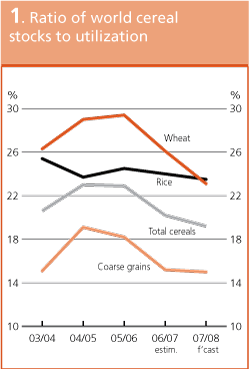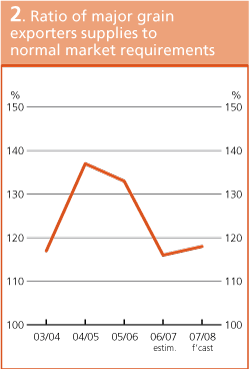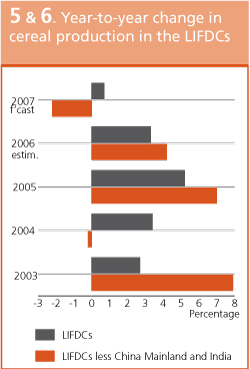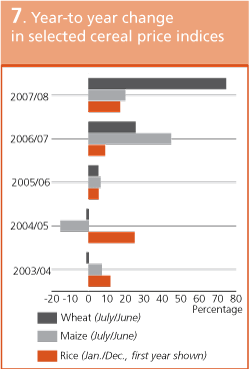|
|
FAO global cereal supply and demand indicators
The ratio of world cereal ending stocks in 2007/08 to the trend world cereal utilization in the following season is forecast to fall to 19.2 percent, the lowest level of the past five years. Surging utilization is likely to absorb most of the anticipated gain in world 2007 cereal production, hence keeping world ending stocks at very low levels. The ratio for wheat is forecast to plummet to 23.1 percent, well under 34 percent observed during the first half of the decade. Contrary to expectations earlier in the season the ratio for coarse grains is now also expected to decrease further from last year’s already low level, to just 15 percent. Likewise, for rice, latest information points to a tighter supply and demand situation than earlier predicted and the stock to use ratio is now forecast to decline to 23.5 percent, also the lowest level in the past five years and well below the average during the first half of the decade.

With the 2007 harvests now complete in the major grain exporters, the estimated ratio of their aggregate cereal supplies in 2007/08 compared to normal market requirements has become firmer and confirms earlier expectations for a surplus of just 18 percent, marginally up from the previous season, but still a relatively low level, considering the figure was over 30 percent in the mid-2000s. This indicates only a small improvement in the ability of these exporters to meet the global demand for wheat and coarse grains imports and points to a likely continuation of a tight market situation in the new season.

The ratio of the major exporters' ending wheat stocks to their total disappearance is forecast precariously low at just 11.7 percent at the end of the 2007/08 seasons. High wheat prices on international markets are already leading to increased import bills for the LIFDCs and should production not increase significantly in 2008 there could be major implications for the supply/demand outlook. For coarse grains, the ratio is expected to decrease further from the previous year's already low level. The fast growing demand for biofuels is expected to keep maize exportable supplies at exceptionally tight levels even with a record harvest. The ratio for rice is also expected to decrease, but relatively less than for the grains.

World cereal production is estimated to be up 4.6 percent in 2007, which would represent a relatively strong rebound after two consecutive years of contraction. However, in view of the tightly balanced situation demonstrated by the first 3 indicators, another good year is needed in 2008, especially for wheat.

Following four years of sustained growth, the cereal production of LIFDCs in 2007 is estimated marginally up from the previous year’s level, which means a less comfortable supply situation in the new 2007/08 season. Excluding China (Mainland) and India, which account for some two-thirds of the aggregate cereal output, production in the rest of LIFDCs is estimated down by 2.2 percent after two consecutive years of substantial increases. This, coupled with population increases, is likely to result in several LIFDCs having to resort to larger imports to cover their consumption needs, which, at a time when international cereal prices are at very high levels, will put a heavy burden on the financial resources of these countries.

The tightening of the global cereal balance in 2007/08 has pushed up prices of all cereals. The most significant increase has been for wheat, for which the price index during the first 7 months of the current marketing year (July 2007 to January 2008), has averaged 74.5 percent above the average for 2006/07. For maize, the price surge has been less significant, with the index rising by nearly 20 percent, but this follows an increase of almost 45 percent also in the previous year. For rice, a modest 17 percent increase has been registered in 2007. These increases are contributing to a significant rise in the cereal import bill of the LIFDCs in 2007/08, which is forecast to jump 35 percent to reach some US$33 billion. Following a sharply increased cereal import bill also in the previous year, this makes the current situation all the more burdensome for the LIFDCs, especially for those countries needing larger imports to cover domestic production shortfalls.

1 The first indicator is the ratio of world cereal ending stocks in any given season to world cereal utilization in the following season. Utilization in 2008/09 is a trend value based on extrapolation from the 1997/98-2006/07 period.
2 The second indicator is the ratio of the exporters’ grain (wheat and coarse grains) supplies (i.e. a sum of production, opening stocks, and imports) to their normal market requirements (defined as domestic utilization plus exports of the three preceding years). The major grain exporters are Argentina, Australia, Canada, the EU and the United States.
3 The third indicator is the ratio of the major exporters’ ending stocks, by cereal type, to their total disappearance (i.e. domestic consumption plus exports). The major wheat and coarse grain exporters are Argentina, Australia, Canada, the EU and the United States. The major rice exporters are India, Pakistan, Thailand, the United States, and Vietnam.
4 The fourth indicator shows the aggregate cereal production variation from one year to the next at the global level.
5&6 In view of the fact that the Low-Income Food-Deficit Countries (LIFDCs) are most vulnerable to changes in their own production and therefore supplies, the FAO’s fifth indicator measures the variation in production of the LIFDCs. The sixth indicator shows the annual production change in the LIFDCs excluding China and India, the two largest producers in the group
7 The seventh indicator demonstrates cereal price developments in world markets based on changes observed in selected price indices.
| Measures taken by governments to limit the impact of soaring international cereal prices on food consumption
|
|
|
International cereal export prices have increased significantly since early 2007. This combined with substantial higher oil prices and freight rates, has sharply driven up the cost of basic food in countries all over the world. In order to limit the impact of rising cereal prices on domestic food consumption, governments from both cereal importing and exporting countries have taken a series of policy measures. Recent developments are listed below:
In North Africa, in Morocco, the Government has cut wheat import tariffs to the lowest level ever. It is also considering privatizing soft wheat imports and providing state subsidies to importers purchasing above a certain benchmark price. In Egypt, the Government has significantly raised food subsidies and signed a bilateral agreement with Kazakhstan for 1 million tonnes of wheat at a preferential price to be delivered during 2008. In Western Africa, in Benin and Senegal, the Governments have taken a series of measures aimed at offsetting a sharp increase in cereal prices, including price controls and the waiving of tariffs. In Eastern Africa, in Ethiopia, the Government has banned exports of the main cereals and grain stockpiling, as well as suspended WFP's local purchases for emergency interventions. It has also imposed a temporary ten percent surtax on luxury imports to fund food subsidies interventions, including the distributing of wheat at subsidized prices to low income urban households. In Southern Africa, in South Africa, adjustments to the amounts paid in social grants to the poor are planned to mitigate the impact of rising food prices. In Zambia, following the recent floods in the country, and in spite of a large exportable surplus of maize in the 2007/08 marketing year (May/April), the Government has reinstated the export ban applicable for any new contracts. In Zimbabwe, the Government continues to control imports of maize, wheat and sorghum which are sold at subsidized prices. Although the increase in import prices has been partially mitigated this year by early import contract of 400 000 tonnes of maize from Malawi, domestic consumer price inflation, measured at over 26 000 percent in November 2007, drastically erodes the consumers’ purchasing power.
In Asia Far East, In China (Mainland), following removal of the VAT export rebate on wheat, rice, maize and soybeans in December 2007, the Government introduced export duties of 20 percent on wheat, buckwheat, barley and oats and of 5 percent on rice, maize, sorghum, millet and soybeans starting 1 January 2008. It has also put in place a 25 percent export duty on wheat flour and starch and 10 percent on the flours of maize, rice and soybeans. At the same time, it has announced its intention to increase the minimum purchase prices of wheat and rice, as well as subsidies to farmers to encourage grain production in 2008. India has removed a 36 percent import duty on wheat flour until April 2009 and has extended duty free imports by private traders. It has also suspended the ban on exports but increased the minimum export price of rice to US$500 per tonne from US$425. Indonesia has removed the 5 percent duty on wheat import and suspended a 10 percent duty on imported soybeans. Pakistan, which started the 2007/08 season exporting large volumes of wheat, mostly wheat flour to Afghanistan, has now banned private wheat exports to Afghanistan and imposed a 35 percent duty on wheat and wheat products exports. It is also purchasing wheat from world markets. In the Republic of Korea, from January 2008 and for six months, import duties on milling wheat have been reduced from 1 percent to 0.5 percent; on maize from 1.5 percent to 0.5 percent, and on soybeans and feed maize from 2 percent to nil. Concerned about the rising food prices, Japan has announced the establishment of a special department in charge of food security and urgent measures to diversify its purchases from world markets. Malaysia is reported to be soon introducing plans for increasing production of wheat flour in response to domestic shortages. In Mongolia, the Government has removed value-added tax from imported wheat and flour with effect from 1 January 2008. In Asia Near East, in Saudi Arabia, the Government announced its plan to reduce the purchasing price of wheat by 12.5 percent per year from 2008, due mainly to limited water resources. Saudi Arabia heavily subsidies wheat production that averages 2.6 million tonnes of wheat per year but based on the new policy, the country is likely to become an importer of at least 3 million tonnes of wheat within the next 10 years. The Government also earlier announced plans to raise the price of wheat sold on local market by 20 to 30 percent from April 2008. Turkey cut import duties on wheat from 130 percent to 8 percent; on maize from 130 to 35 percent, and on barley from 100 percent to nil. In Jordan, the Government continues to subsidize wheat but its subsidy on barley has been partially lifted since October 2007. It has also stepped up its wheat purchases in world markets and announced its plan to increase stocks up to a 6 months consumption level.
In Latin America and the Caribbean, in Mexico, starting January 2008, the Government completed removal of quotas and tariffs that were in place since 1994 to protect maize, pulses, milk and sugar under the North American Free Trade Agreement (NAFTA) with Canada and the United States. Argentina reopened its grain export registry. A maximum of 400 000 tonnes of wheat exports will be authorized on a monthly basis over a period of five months, while maize exporters will be able to register exports for shipments starting from mid-February but quantities have not yet been announced. Brazil is considering a reduction or removal of the 10 percent import tax on wheat from origins different than Argentina which is already tax-free. In Peru, tariffs on imports of wheat and maize and all flours, which ranged from 17 to 25 percent, have been removed. In Ecuador and Bolivia, the Governments have introduced subsidies to bread production.
In Europe, the EU removed the 10 percent compulsory set-aside requirement for the 2008 cropping season and subsequently suspended cereal import duties (excluding oats, buckwheat and millet) from last December until the end of the current marketing season in June 2008. Starting from the end of January 2008, the Russian Federation has raised wheat export duties from 10 percent to 40 percent (or no less than €105 per tonne). However wheat flour exports are not subject to a duty and the country is reported to have boosted its flour exports. The Government is also considering the extension of the price freeze on basic foodstuffs, including bread, milk, sunflower oil and eggs to May 2008. Ukraine is considering adding wheat and rye flour to the list of commodities under state price control. The Government is also considering increasing grain export quotas from 1.2 million tonnes set in September 2007 to 2.4-2.9 million tonnes from March 2008.
|
|
 February 2008
February 2008 